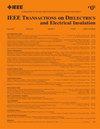用于电力变压器绝缘和冷却的纳米电介质流体:确定挑战和未来研究需求的综述
IF 2.9
3区 工程技术
Q2 ENGINEERING, ELECTRICAL & ELECTRONIC
IEEE Transactions on Dielectrics and Electrical Insulation
Pub Date : 2024-09-12
DOI:10.1109/TDEI.2024.3459861
引用次数: 0
摘要
在包括美国在内的许多国家,许多油浸式电力变压器(pt)达到其设计使用寿命已经变得越来越普遍。绝缘问题是变压器故障的根本原因。由于巨大的资本成本、定制的设计和交付的较长时间,替换这些基本元素资产是不太可取的,特别是对于大型资产。相反,探索新的绝缘系统,可用于升级现有的油浸式变压器被考虑。另一方面,改善电绝缘和热管理的新型绝缘系统也对新PTs具有吸引力,从而导致更高密度的设计。本文综述了纳米介电流体作为变压器油替代品的研究进展。ndf是纳米流体(NFs),其中基流体是电介质。在介质液体中加入不同的纳米粒子(NPs)将得到纳米介质液体。1995年,Choi和Eastman发明了据称具有增强热输运特性的NFs,彻底改变了PT油的研究领域。对PT油进行了类似的研究,发现NPs也能提高介电性能。这一革命性的研究领域引起了全世界许多研究人员、科学家和实业家的兴趣。然而,仅仅将任何NP与PT油混合来合成NDF并不容易。合成NDF时应考虑NDF的稳定性、NP浓度、粒径、形状、NDF粘度、表面活性剂的选择、表面活性剂的浓度、超声时间和成本等因素。尽管使用各种基础流体和NPs进行了许多研究,但用于PTs的商业化ndf尚未实现。本文批判性地回顾了针对PTs的ndf所做的调查,确定了技术差距,并强调了未来的研究需求。因此,它可以成为进一步研究的宝贵资源。本文章由计算机程序翻译,如有差异,请以英文原文为准。
Nanodielectric Fluids for Power Transformer Insulation and Cooling: A Review Identifying Challenges and Future Research Needs
It is becoming increasingly common for many oil-immersed power transformers (PTs) in many countries, including USA, to reach the end of their designed service life. Insulation issues fundamentally cause transformer failure. Due to the significant capital cost, customized design, and long lead time for delivery, it is less desirable to replace these essential element assets, especially for large ones. Instead, exploring novel insulation systems that may be used to upgrade existing oil-immersed transformers is considered. On the other hand, novel insulation systems that improve electrical insulation and thermal management are also attractive for new PTs, which lead to higher density designs. This review investigates nanodielectric fluids (NDFs) as alternatives to transformer oils. NDFs are nanofluids (NFs) wherein the base fluid is dielectric. Adding different nanoparticles (NPs) to the dielectric liquids will result in nanodielectric liquids. Choi and Eastman in 1995 revolutionized the area of PT oil research by inventing NFs that are said to have enhanced thermal transport properties. Similar investigations on PT oils led to the discovery that NPs are capable of enhancing the dielectric properties as well. This revolutionary research field has piqued the interest of many researchers, scientists, and industrialists all over the world. However, it is not easy to synthesize an NDF just by mixing any NP with PT oils. Several factors, such as NDF stability, NP concentration, size, shape, NDF viscosity, choice of surfactant, concentration of surfactant, time of ultrasonication, and cost, should be considered while synthesizing an NDF. Although many studies have been conducted using various base fluids and NPs, commercial NDFs for PTs have yet to be realized. This article critically reviews investigations done on NDFs for PTs, identifies technical gaps, and highlights future research needs. As a result, it can be a valuable source for further research.
求助全文
通过发布文献求助,成功后即可免费获取论文全文。
去求助
来源期刊
CiteScore
6.00
自引率
22.60%
发文量
309
审稿时长
5.2 months
期刊介绍:
Topics that are concerned with dielectric phenomena and measurements, with development and characterization of gaseous, vacuum, liquid and solid electrical insulating materials and systems; and with utilization of these materials in circuits and systems under condition of use.

 求助内容:
求助内容: 应助结果提醒方式:
应助结果提醒方式:


